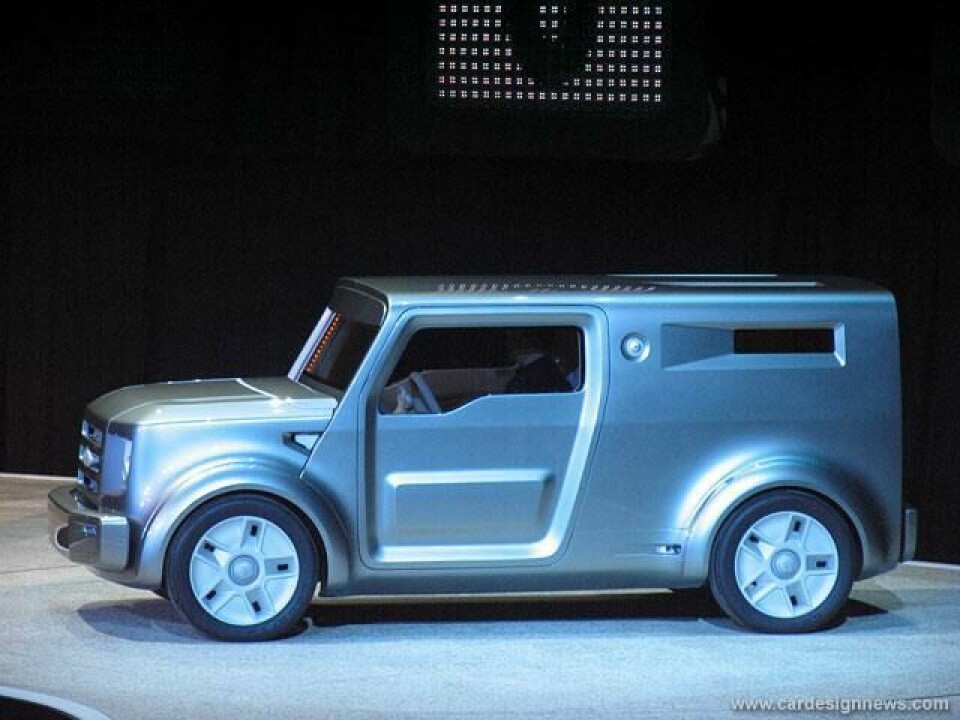
Ford SYNus Design Review
A review of Ford’s small cuboid
Jan 27, 2005 – America is famous for its big cars. For a non-American, to think ‘American car’ is to think big finned late-fifties sedan, huge cop car or New York cab, or pick-ups that are longer than a long wheelbase Mercedes S-class. Big cars make sense in a country that takes four or five days to drive across, has half the population density and a fifth the fuel cost of Europe. But perhaps in the future they will make less sense.
This is a perspective that Ford’s design group have embraced with one of their latest concept cars; the SYNus.
The conceptual background to the SYNus is that Americans (like many other nationalities) are moving back to the cities. They see this as a macro trend: 100 years ago farm workers began moving to the city as industrialisation took place; 50 years ago the post war American moved out of the city to the suburbs; now these, typically smaller, American households are moving back to the city. And as cities become more crowded so the need for a more urban orientated, smaller car might be expected to grow.
So the SYNus is a small car for future North American cities, places Ford assumes will be posing increased threats to personal security and still be populated by large vehicles. These assumptions led the design team headed by interior designer Joe Baker to compensate the SYNus’s relatively diminutive stature (the car was based on the European B-class platform of the Fiesta, Fusion and Mazda 2) with a very tough exterior design identity, and to complement this with a warm, calm and ensconcing interior design identity - a haven away from the big bad world outside.
The tough looking exterior from designer Jose Paris makes the SYNus’s strongest statement. The surfacing isn’t ‘product design’ geometric and clean in the way that many other similar sized concepts from Europe and Japan have been, but almost slightly voluptuous; look at the way the wheel arches are convex surfaced blisters atop a concave body side surface that comes out to them, or the subtle curve to the body side in section that gently accelerates into the top corners of the car and then decelerates into the roof - most evident from the car’s rear aspect - no straight lines or clearly delineated constant radius curves in sight. One of the strongest factors behind this form language was the consideration of the SYNus’s audience in its natural, crowded urban habitat always being close up to it - a factor prevalent today in Korean car design, but not American car design.
Whilst the form can’t be described as ‘product design’, with the exception of the body side crease and brutal truck-like Down-Road-Graphic it certainly isn’t automotive in the conventional sense. The side and rear doors’ sunken surface gives the impression that they are the female mould of a heavy duty door panel press, not an inaccurate impression as they are milled from 150mm thick solid aluminium!
Other aspects of this new ‘built tough’ Ford aesthetic include an open ended rounded rectangle motif evident in the rear side windows, front lights, rear number plate surround and the aperture just forward of the front window. Also a stepped DLO (from the F-150 truck and similarly sized European Transit), chunky separate bumpers and flat windscreen.
This is then accentuated by details such as the dial-operated combination lock on the driver’s side, rear door vault style spinner opening mechanism and slot like side windows to make the car a caricature of a security van (‘Brinks’ was one of the earlier possible names for the car), this slightly tongue in cheek approach underpinned by its ‘Tough Love’ number plate.
But there could be serious real world application of this new robust form language on, for example, a future Ford pick-up or SUV.
The contrast inside is stark; refreshingly it is not the brutal, masculine interior design identities of other concept vehicles with similarly tough looking exteriors. Accessed from the rear or either side, the right side having an additional rear hinged discreet door, it is a physical manifestation of ‘ambient’. Soft lozenge forms, surfaces that closely relate to those of the exterior and quiet beige hues with partially hidden and recessed thin beads of orange illumination make an exceptionally calm, sanctuary of an interior that is minimalist in its content and yet also rich in its ambience.
The rear area is lit by the side and roof slot windows, and with front seats flipped back (like an old fashioned tram seat) and rear seats folded into the floor, it is a perfect space in which to watch films, the internet or view outside of the car on the 1150mm wide LCD screen on the rear door. Or for a couple to close the window shutters and leave some personal impressions on the padded memory material of the inside walls - the SYNus seems to acknowledge that sex in cars is as part of the future as it is the past.
Nearly a decade ago in Europe the Smart City Coupe (now named For Two) shifted perceptions of small cars. At 2.5 metres long it was two thirds the length of a normal European car.
The SYNus, if made, could be the American equivalent; at 3.8 metres long it is two thirds the length of America’s best selling vehicle; the Ford F-150 pick-up. And like the Smart in Europe, the Nissan Cube in Japan, and the similarly small American market Honda Element, Scion SC and Mini Cooper, it is young minded, desirable in its own right, and crucially not just a smaller and cheaper version of a large car. Could this be the start of a change in perceptions as to what an American car is? Think American car, think micro security van? Could be.




























